Business Process Reengineering is Quick and Easy
The Ultimate Guide to Business Process Reengineering

Free Bonus Content: Get Your Free Business Process Reengineering (BPR) Implementation Guide!Click Here To Download It.
Business is a battle. A war to get the attention you deserve.
Your enemies? The numerous competitors striving to gain prominence.
Of course, the battle is not for the faint-hearted.
Business involves so many obstacles. You need a superb product. You must market it to potential customers. You need to evaluate your processes. You need to meet the demands of our evolving society and your growing customers. In short, the list is endless.
But none of these matter if your business process suck. If customers aren't satisfied with the way your business is run, then you might as well lay your sword down in defeat. Customers are in search of the best.
So before you decide to kick-start your business, it's better to learn about business process reengineering (BPR).
You must rethink how your business works in order to improve customer service, cut operational costs, and become a world-class competitor.
Skip that step, and nothing can save your business.
The good news is, the secret to reengineering your business process is right here at your fingertips. It's the secret of top businesses in the world.
You have a powerful product that can change the world, that product is worth fighting for. So when you're ready to enter the battleground, arm yourself with this guide and fight the good fight. It's a battle you must win.
In this guide, we answer questions on the how, why, where and examples of BPR. What's included is as follows:
Chapter 1 – How BPR Came About: What It means?
Chapter 2 – Why Try BPR?
Chapter 3 – Still in Doubt? Where to Apply BPR
Chapter 4 – The Seven Myths of BPR: What You Need to Know.
Chapter 5 – BPR Best Practices: How to Achieve BPR Success.
Chapter 6 – The BPR Process for Success.
Chapter 7 – BPR and Information Technology: An Inseparable Duo.
Chapter 8 – Case Scenarios: Some Famous Examples of BPR.
Chapter 9 – The BPR Methodology: How to Implement BPR in Your Business.
Chapter 1 – How Business Process Reengineering came about: What it means?
According to the management study guide,
"BPR is the fundamental rethinking and radical redesign of business processes to achieve dramatic improvements in critical contemporary measures of performance, such as cost, quality, service, and speed."
This definition is clearly not for the layman.
Cleverism puts it more succinctly:
"The concept of business process reengineering (BPR) is to rethink and break down existing business processes. This allows a company to reduce costs andimprove productivity through newer, more efficient processes"
More approachable, isn't it? However, let's move onto a more practical definition.
Search CIO defines BPR as
"the analysis and redesign of workflows within and between enterprises in order to optimize end-to-end processes and automate non-value-added tasks"
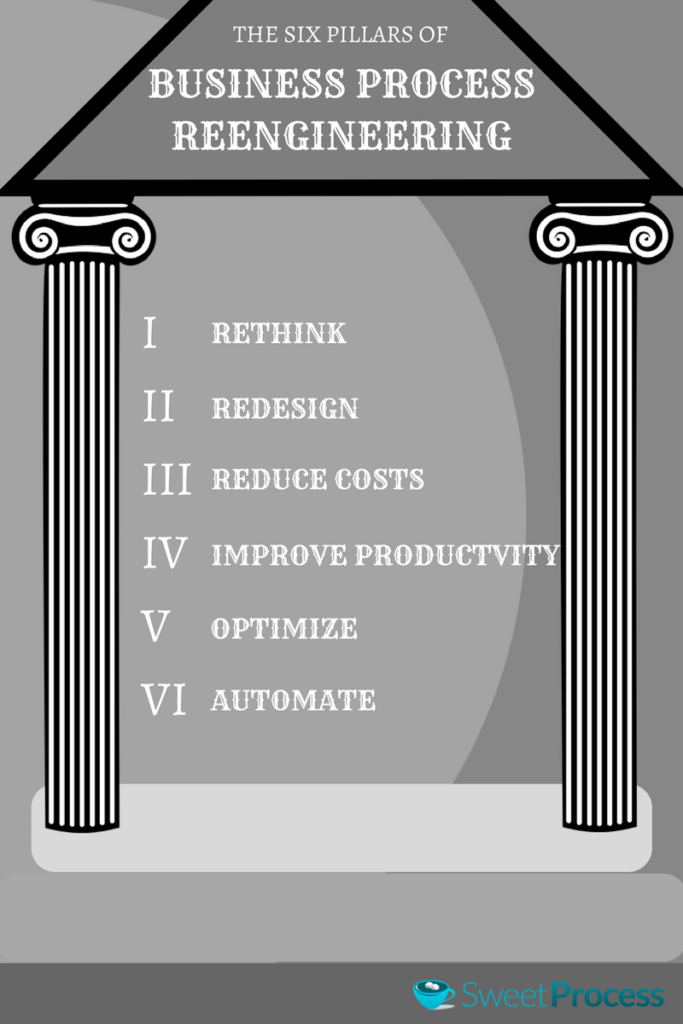
Don't Automate, Obliterate: How BPR was formed?
It was in 1990, when Michael Hammer, a former Professor of Computer Science at the Massachusetts Institute of Technology (MIT), published the article "Reengineering Work: Don't Automate, Obliterate" in the Harvard Business Review in which he claimed that the major challenge for managers is to obliterate forms of work that do not add value, rather than using technology for automating it.
What Was Hammer's Claim?

Image Credit: Dr. Michael Hammer and Shawn G. Henry
His claim was simple: Most of the work being done by businesses do not add any value for customers, and this work should be removed, not accelerated through automation. He proposed that companies should reconsider their inability to satisfy customer needs and reengineer their processes.
Hammer affirms that with BPR, businesses:
- Will add more value to customers
- Accelerate their processes
- Focus only on what matters
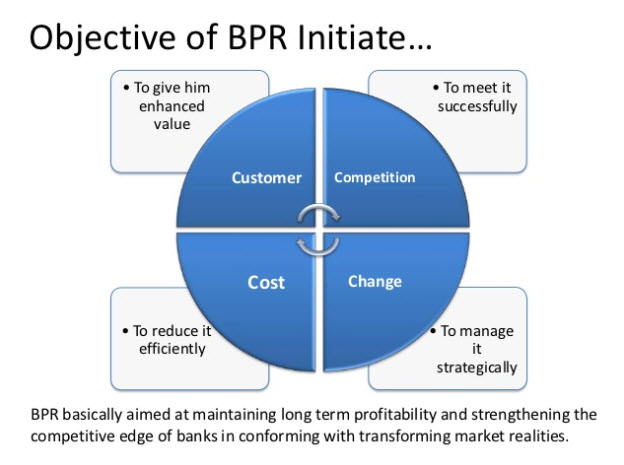
Image Credit
Was BPR's Goal Derailed?
Many companies used reengineering as a reason to downsize although this not the intent of reengineering's proponents. In the long run, the concept earned a reputation for being known with downsizing and layoffs.
This forced Thomas Davenport, an early BPR proponent, to posit the following in the 1995 article "The Fad That Forget People":
"When I wrote about "business process redesign" in 1990, I explicitly said that using it for cost reduction alone was not a sensible goal. And consultants Michael Hammer and James Champy, the two names most closely associated with reengineering, have insisted all along that layoffs shouldn't be the point. But the fact is, once out of the bottle, the reengineering genie quickly turned ugly."
Three Years Afterward: How Has BPR Fared?
Within three years of Hammer's proposal, BPR gained wide acceptance, and about 60% of the Fortune 500 companies then have either reengineered their process or were about to do so. Today, business process reengineering is still making a splash. Many companies have adopted it and seen higher productivity, more competitiveness, and a larger customer base, as we discuss later on.
This short video provides an introduction to business process reengineering:
Principles of BPR
The principles of BPR (now known as techniques) as suggested by Hammer and Champy in their book include the following:
- Organize around outcomes, not tasks.
- Identify all the processes in an organization and prioritize them in a redesign urgency order.
- Integrate information processing work into the real work that produces the information.
- Treat dispersed resources from various areas as though they were centralized.
- Link activities that are parallel in the workflow, instead of just integrating their results.
- Make performance the ultimate decision point and build control into the process.
- Get information once and at the source.
What Do These Principles Mean for Your Business Process?
- Examine all the tasks working to achieve the same goal and combine various jobs into one.
- Prioritize the actual work where it makes more sense. Hence, parallel processes leading to the same outcome should be connected within the process, rather than combining results at the end.
- Eliminate any unnecessary control systems. Instead of having extra processes to enter related information, a resource within the process should provide all necessary data.
Chapter 2 – Why try BPR?
As a business owner desirous of change, you need to constantly evaluate your processes to meet the demands of the evolving society and your growing customer.
According to Wikipedia, business process reengineering is a business management strategy that focuses on the analysis and design of workflows and business processes within an organization.
So what does BPR aims to achieve in every organization? In this chapter, we take a look at its aims and objectives and why your company should invest in it.
With business process reengineering, you'll achieve the following for your company
- Customer focus: The ultimate reason for BPR is the customer. With it, you provide your customers a better service.
- Speed: The speed at which your business operates quadruples. For instance, if the process before BPR had an average cycle time of 10 hours, afterward, the average cycle time should be cut down to less than three hours.
- Compression: You are able to cut major tasks of cost and capital throughout the value chain.
- Flexibility: You become closer to the customer. The company can develop a mechanism that makes it aware, able to spot the weak points, and adapt to new market requirements.
- Quality: Processes, not necessarily just individuals, affect quality levels. As BPR helps improve the former, it also improves the latter.
- Innovation: The company innovates new processes.
- Productivity: BPR drastically improves your effectiveness and efficiency.
In the following video, Michael Hammer discusses business process reengineering, what it means, and why your company should consider it.
In a nutshell; business process reengineering:
- Reduces cost and cycle time: BPR eliminates unproductive activities and redundant human labor. It also aids a business in reorganizing by teams, accelerates information flows, and gets rid of errors and job repetitions.
- Promotes quality: BPR simplifies who does what in a business. This increases accountability among workers. It also helps management and customers receive quick feedback.
- Ensures customer satisfaction: If customers' needs are quickly fulfilled, they are likely to feel satisfied and come back for more.
Chapter 3 – Still in doubt? Where to apply Business Process Reengineering.
Understanding the Importance of BPR: A Case Scenario
Let's consider a case scenario to help you understand why BPR is an important decision for your company:
Customer A ordered goods from a particular company, but after some time, he still hasn't received his order. He begins worrying and calls the company to ask why.
"Let me transfer you to the accounting department to check if the order was invoiced," responds the telephone operator.
Now, the customer must explain his problem to the accounting department again who had this to say: "We invoiced your order, but I don't know if it has been shipped. You need to talk to the logistics department. Unfortunately, I could not transfer you since they are located in another city."
Thereafter, the customer calls the logistics department and explains the situation again. The
logistics manager responds, "Although the order should have been delivered, I haven't yet received the order from the production department. Please hold on a minute. I will try to contact them to find out what happened."
Then, the inventory manager tries to help resolve the situation. Sensing the customer is becoming furious, he says, "Sir I am sorry, it is the finish department's fault. Somebody forgot your order in the finish storage. I will send it to you as soon as possible."
After this encounter, do you think the customer would place another order with the same company?

Image Credit
The above scenario is what happens in a company without business process reengineering.
What Did You Note About the Scenario?
Throughout the conversation, you might have noticed an emphasis on individual departments and their functions. Most of the employees indicated they did their jobs but don't know if others have done the same. Nobody took full responsibility. As awkward as the situation seems, it's prevalent in many companies and organizations.
How Does a Company Without BPR Reacts?
The truth is, if management of this company overheard the conversation, they would desperately seek a solution. Often, what they would do is restructure the organizational chart, replace people in the company's hierarchy, or adjust the roles and responsibilities of some employees.
Even with that, the status quo remains. The desired outcome is not achieved as efforts crash into departmental barriers. This is due to the employee mentality to always protect their personal or functional interests.
What a BPR Company Does Differently
With BPR, the story is not the same. This is because the company is organized based on processes. The company has an order processing team, thereby breaking down departmental barriers.
The team would be composed of a case manager to respond to the customers' requests, and employees from the accounting department, the logistics department, and the production department. The process is designed to unfold in a step-by-step order with a response quickly provided to the customer.
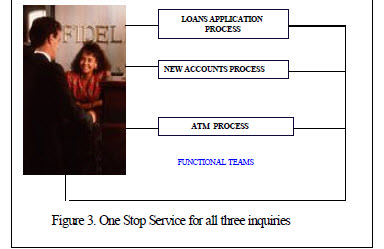
Image Credit
With BPR, the customer only has to speak to one person — the case manager. All internal controls are the responsibility of the order processing team. This way, customer needs are met without any hitches.
Companies That Have Used BPR
Many public and private sector organizations and SMEs world-wide have undergone major
Business process reengineering efforts. These top tier have applied BPR and seen positive results. Some of them include:
- IBM
- AT&T
- Sony
- General Electric
- Walmart
- Hewlett-Packard
- DEC
- Kraft Foods
- Citibank
- Northwestern Bank
- Bank of America
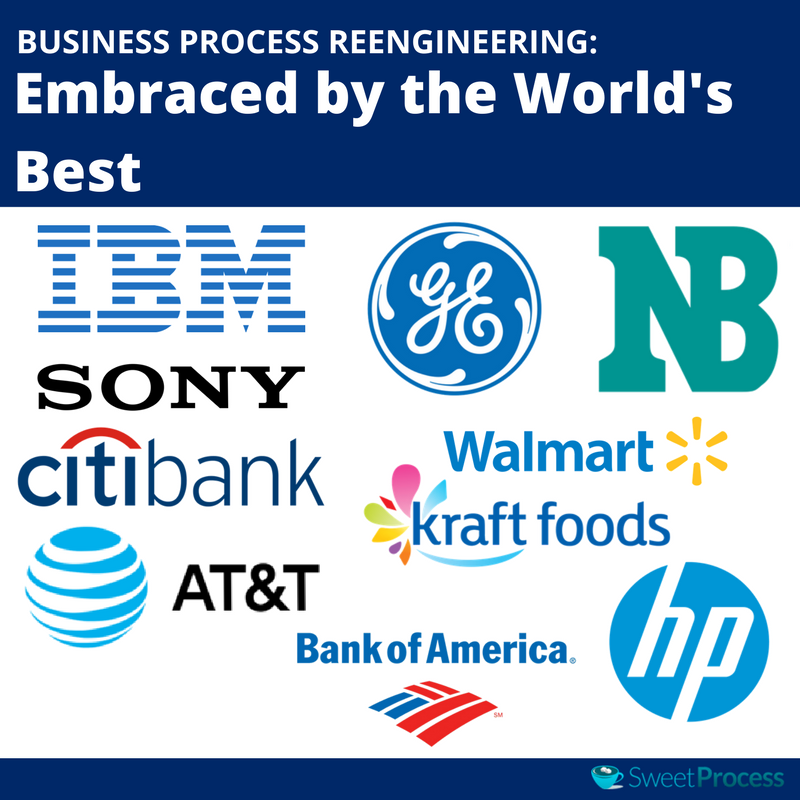
How to Determine If Your Company Is Ready for BPR?
Your company should first consider four key business process reengineering questions cited in the article. Moreover, it needs to meet the following conditions before you can consider BPR:
- Minimum Number of employees: 20 (at least 4 in management positions).
- Strong management commitment to innovation: Management should be passionate about new ways of working and innovation.
- Well-formed IT infrastructure: BPR cannot work without adequate IT infrastructure. You must be ready to heavily invest in information technology.
The table below outlines the changes that will need to happen in your company when implementing BPR:
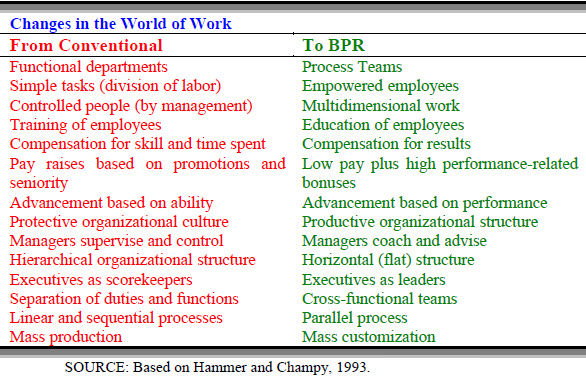
What Problems Can BPR Solve for Your Company?
Business process reengineering can offer solutions to multiple issues, including:
- High operational costs
- Low quality offered to customers
- High level of "bottleneck" processes at pick seasons
- Poor performance of middle level managers
- Inappropriate distribution of resources and tasks
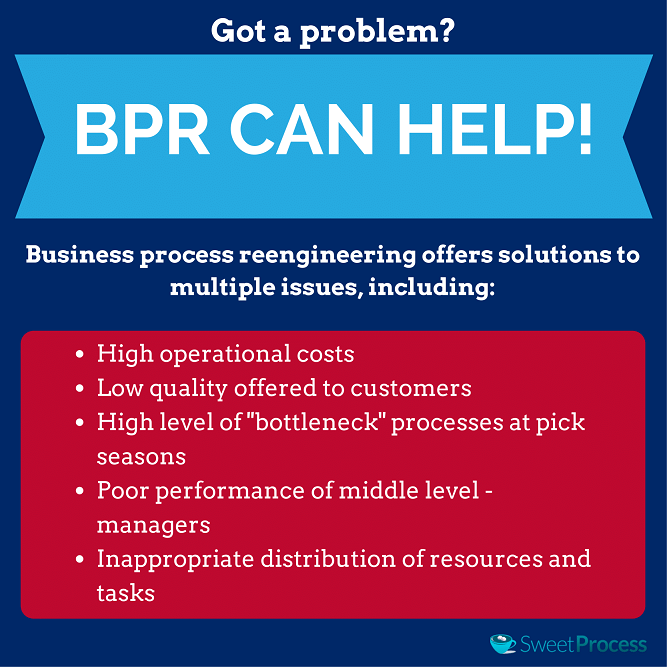
Chapter 4 – The Seven Myths of BPR: What You Need to Know.
Before you start implementing business process reengineering in your company, you should understand common myths associated with it and how they related to our business. Some of these myths include:
1) BPR doesn't need to happen on ERP projects: This could be regarded as the most misguided of all the BPR myths. Every enterprise resource planning (ERP) system (software that integrates your core business processes and can be used to collect, store, manage and interpret data) will most likely affect your business processes. While most of these changes will be positive improvements, some effort will still be required to adapt to the new environment.
2) Simply implementing a new ERP system will drive process improvements: This may as well be regarded as the most myth in the industry regarding business process reengineering. ERP systems nowadays are extremely robust and flexible.
3) ERP project teams should focus on "to-be" rather than "as-is" processes: If you are a business or organization making the changes or the employees doing the work every day, then the current processes absolutely do matter. Therefore, it is important that you examine the current status of your processes.
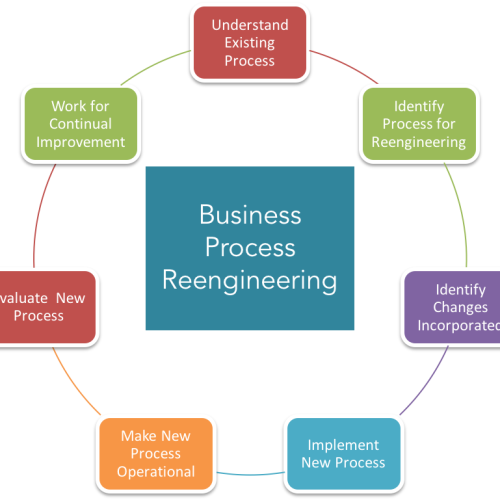
Image Credit: Consultivo
4) Business process improvements can be done without organizational change management : Many executives think that they can implement business processes without changing management. This is, however, a very misguided view because the most effective business process reengineering efforts succeed largely because of the way the organization changes and not due to the optimized processes.
5) You can't reengineer business processes before knowing which software you are going to implement : Thehow, what and whenof what your business does is not tied to your software. Though a new ERP greatly improves the business process, the general nature of your business operations won't change much. Thus, it is better to evaluate and improve your business processes before you select or implement any new system.
6) All business processes need to be overhauled before selecting and implementing a new ERP system : Some executives believe that they need to totally reengineer their business before selecting and implementing a new ERP system. This is not true. Rather, what most successful businesses focus on is improving their major areas of competitive advantage as part of their ERP implementations.
7) Business process reengineering will cause my ERP implementation to take more time and money to implement : The undoing of many failed ERP implementations is to assume that "doing things right" will cost more time and money than cutting corners along the way. It may look good on paper to exempt the tedious aspects of business processes, but the reality is that your project will most likely take longer to implement and likely fail if you toe that line.
Chapter 5 – Business Process Reengineering Best Practices: How to Achieve BPR Success.
Many unsuccessful BPR attempts may have been due to the confusion surrounding the concept and how it should be performed. Organizations know that they need to make changes, but they do not know exactly where to or how to do so. As more businesses reengineer their processes, knowledge of what caused their successes or failures is becoming apparent.
In this chapter, we look at BPR best practices to ensure a successful execution. A BPR program can be successful through the following:
– Customer needs' satisfaction: Customer needs are prioritized, and this vision is used to appropriately direct business practices.
– Business needs analysis: There are cost advantages to be achieved that aid the organization become more competitive.
– BPR team composition: A critical analysis of all operational processes is taken, with relevant questions being asked about the established way of working and how it can be developed.
– Ongoing continuous improvement: There is a desire to look beyond tasks and traditional functional boundaries and focus on outcomes. With this, you can minimize entire processes into fewer but more important improvements.
– Effective change management: There is a willingness to simplify the way work is completed. You do this by assessing all activities and tasks and eliminating those that do not add more value.
– Adequate IT infrastructure: There is a willingness to invest in the IT infrastructure of the company.
A BPR program will fail due to the following:
– Lack of recognition of the extent of the problem: If there is no clear willingness to put all existing processes to the test, there is no chance of success
– Lack of training: Without training, BPR will fail. This is because it will be seen as a one-time, cost-cutting exercise. But in reality, cost reductions are byproducts of the activity and not the primary concern.
– Inadequate infrastructure: There is need for adequate infrastructure and support from the management and employees. Many BPR initiatives never take off because effort is not put into securing support.
– Optimizing one department at the expense of another: There needs to be an openness in evaluating every single process in detail. Likewise, there should be a willingness to change whatever is needed to achieve overall efficiency.
– Lack of time to focus on improving business process: There is too much internal focus and not enough of an eye on the industry and what competitor best practices can be used as benchmarks.
Building a BPR Team for Your Company
The BPR team represents an important aspect of the BPR effort because they make key decisions and recommendations and also help communicate the details and benefits of business process reengineering to the entire organization.
The most effective BPR teams include active representatives from the following work groups:
- Top management
- Business area responsible for the process being addressed
- Technology groups
- Finance
- Members of all ultimate process users' groups.
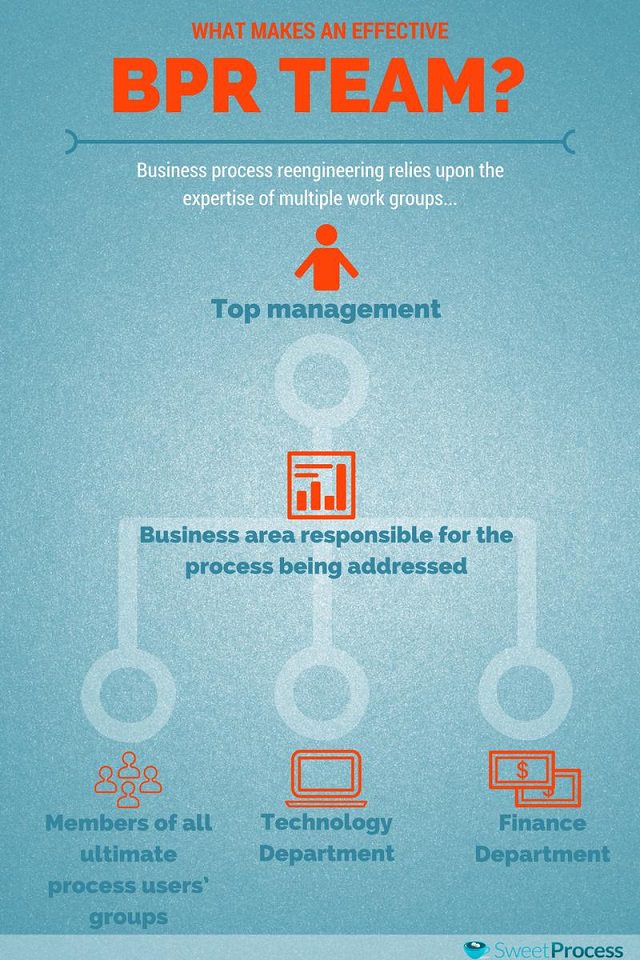
It is also recommended to have a diverse BPR team in terms of contextual knowledge. For instance, a BPR team could comprise the following:
- Members who do not know the process at all
- Members who know the process inside-out
- Customers, if possible
- Members representing affected departments
- One or two members of the best, brightest, passionate, and committed technology experts
- Members from outside of the organization
The organization should keep the team at a manageable size. If they fail to do so, the entire process will be much more difficult to execute efficiently and effectively.
Chapter 6 – The BPR Process for Success.
Before embarking on BPR, you must implement certain processes to ensure success at the end of it all. In this chapter, we examine these processes.
– Prepare for BPR: Planning and preparation are vital for any activity to be successful. As they say, "If you fail to plan, you plan to fail." As part of your preparations, you need to understand customer expectations and where your existing process falls short of meeting their needs. After identifying these customer-driven objectives, you can formulate the mission or vision statement.
– Map and analyze the as-is process: Before the reengineering team can proceed to redesign the process, they should understand the existing process. One of the most important aspects of BPR is that improvements should lead to dramatic results. This as-is phase must be thoroughly understood and analyzed. Without it, you will find it difficult to add any value to the process.
– Design to-be process: The objective of this phase is to produce one or more alternatives to the current, existing business process. The first step is benchmarking. The term refers to "the comparing of both the performance of the organization's processes and the way those processes are conducted with those of relevant peer organizations to obtain ideas for improvement." The several to-be models finally developed are validated.
– Implement reengineered processes: This is the most difficult stage, as there is a lot of resistance to BPR here. In this phase, the transition plan is validated and its pilot versions are designed and demonstrated. Likewise, training programs for workers are initiated, and the plan is executed on a full-scale level.
– Improve Continuously: A process cannot be reengineered overnight. Hence, the need to improve the reengineered process continuously. Here, you must monitor two aspects: the progress of action and the results. The former is measured by gauging how much more informed the people feel, how much more commitment management shows, and how well the change teams are accepted by those in the organization. As for monitoring the results, this includes such measures as the attitude of employees, customer perceptions, supplier responsiveness, and so on.
Want to know more? This video explains the BPR process in detail:
Chapter 7 – Business Process Reengineering and Information Technology: An Inseparable Duo.
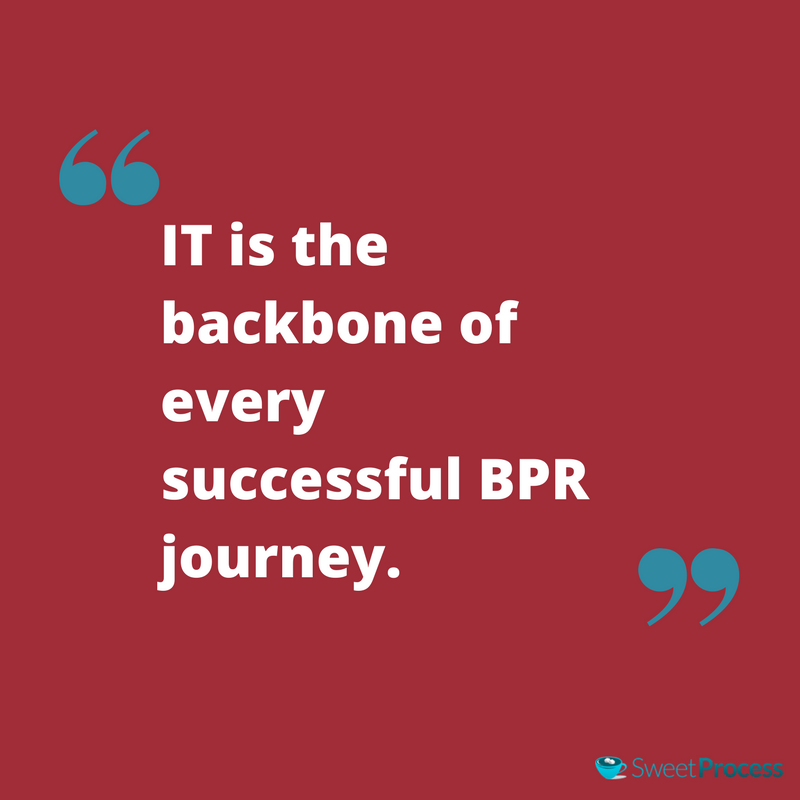
Over time, information technology has grown into a significant aspect of reengineering. Many consider it key to enabling new forms of working and collaboration within an organization. Hence, IT is the backbone of every successful BPR journey. In this chapter, we take a cursory look its role in BPR success, including:
– Shared databases: Quick and convenient communication and information sharing is necessary. This will only be realistic only if information can be accessed in various ways.
– Expert systems: It is important to identify general and specific tasks. Robust IT infrastructure allows generalists to perform specialist tasks and vice versa.
– Telecommunication networks: They help organizations achieve their set goals in allowing them to be centralized and decentralized at the same time.
– Decision-support tools: Decision-making is an important aspect of every business. IT can make it easier, and decision-support tools make IT a part of everybody's job.
– Wireless data communication and portable computers: In many businesses, less emphasis is placed on employees always working from one particular location. This allows field personnel to work independently from the office.
– Interaction on the go: Getting along with customers is an essential part of every business. When BPR is in place, good IT infrastructure makes it easy to get in immediate contact with potential buyers.
– Automatic identification and tracking: Good and personnel must be tracked at all times for efficiency. IT infrastructure lets you know where things are, instead of having to find them on your own.
– High performance computing: Computing is at an advanced stage. It's better to do things on the go. This allows on-the-fly planning and revision
Chapter 8 – Case Studies: Some Famous Examples of BPR.
As mentioned before, major companies across the world have implemented BPR and achieved astonishing results. In this chapter, we take a look at some peculiar case scenarios detailing the company's situation before BPR and the results after BPR implementation.
Ford Business Process Reengineering
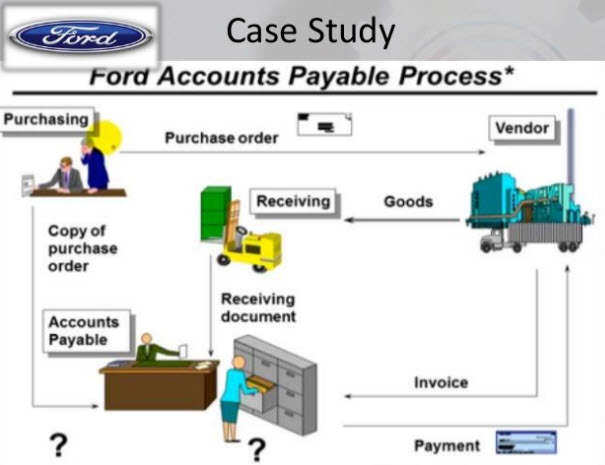
Image Credit
Ford was well-known for its invoice system known as the account payable process. It involved the purchasing department initially sending a purchase order for raw materials to the vendor. Next, the department would send a copy to the accounts payable department. After sending the raw materials, the vendor sends an invoice to the accounts payable department, which then tallies the purchase order, received materials, and invoices, and thereafter makes payments to the vendor. To keep this tedious process afloat, Ford employed about 500 people.
What They Observed in Their Competition?
Ford's major competitor, Mazda, a Japanese car manufacturer, managed to perform the same process with just 100 people, a remarkably low number of employees, even considering the company's size.
How Business Process Reengineering Came into Play
Michael Hammer proposed something radical to Ford: Eliminate the invoice. This meant a buyer would no longer need to send a copy of the purchasing order form to the creditor administration. Instead, a buyer would log an order in the online database. When the items appear at the store, the storekeeper would check they corresponded to the purchase order in the system.
This new system used information technology to change the accounts payable process. It implemented an invoice-less process. The purchasing department would create a purchasing order and update it in the database. As soon the materials arrive, a warehouse worker would check the materials received and confirm delivery. Next, payment would be made automatically without waiting for an invoice from the vendor.
Ford benefited drastically from this change. It resulted in almost a 75% decrease in personnel in the accounts payable department.
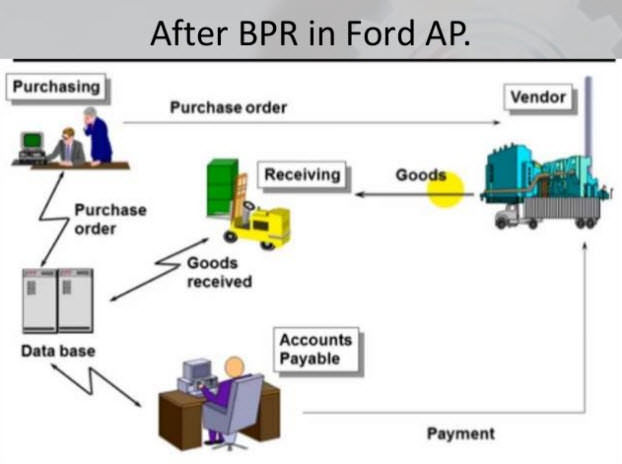
Taco Bell Business Process Reengineering
Taco Bell has grown from a $500 million company in 1982 to a $3 billion company (early 1990s).
What Happened?
Taco Bell reimagined their business, focusing more on the retail service aspect and centralizing manufacturing. The K-Minus program was created, and the meat, taco shells, beans, lettuce, cheese, and tomatoes were now prepared in central commissaries outside the restaurant. When a customer makes an order, the prepared ingredients are then assembled.
The image below details problems Taco Bell faced and how business process reengineering solved them.
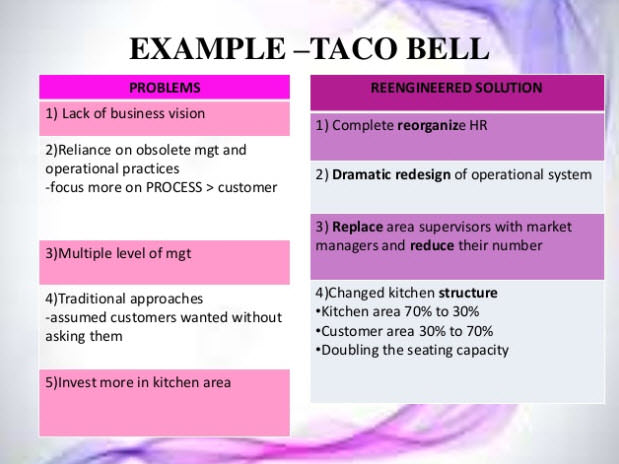
Image Credit
So what did Taco Bell achieve with BPR? Better employee morale, increased quality control, fewer accidents and injuries, bigger savings, and more time to focus on the customer.
Hallmark Business Process Reengineering
Hallmark used to spend three years bringing new products to the market. With more niche markets identified, its executives were convinced that the product development process needed to be redesigned. Using reengineering, the goal was set to reduce the cycle time to one year.
What Did They Discover?
They found out that two-thirds of the product cycle was spent on planning and conceptualizing the card, rather than printing and production as had previously been thought. The concept spent 90% of the time waiting for a creative staffer to complete a new iteration till it was eventually finalized.
The Results
By creating a cross-functional team for product development, in 1991, a new line of cards was brought to market ahead of schedule in eight months.
Chapter 9 – The BPR Methodology: How to Implement BPR in Your Business.
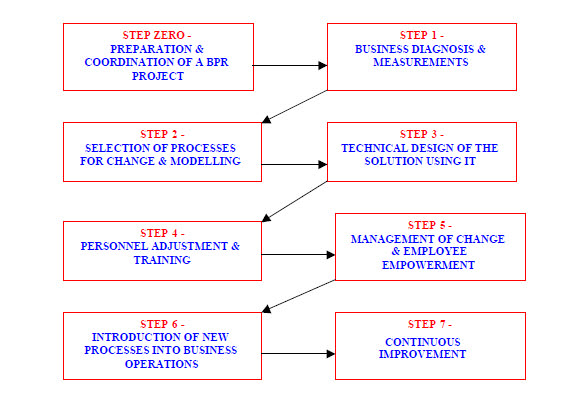
Image credit
Step Zero – Preparation and Coordination.
Objectives:
- To establish strong management support
- To explain to the members of the BPR implementation team the project details and their roles
Step 1 – Business Diagnosis & Measurements
Objectives:
- To diagnose and identify problematic areas in current processes
- To measure the performance characteristics of the current processes based on measurable factors, such as average cycle time, delays, number of mistakes or number of customer complaints
Step 2 – Selection of Processes for Change and Modeling
Objectives:
- To identify the strategic processes that are feasible to change
- To redesign and model the selected processes
Step 3 – Technical Design of the Solution
Objectives:
- To automate modeled business processes (step 2) using networks and workflow tools
- To redesign and model the selected processes
Step 4 – Personnel Adjustment & Training
Objectives:
- To train personnel in the new ways of working using IT in the redesigned processes
- To redesign and model the selected processes
Step 5 – Management of Change & Employee Empowerment
Objectives:
- To establish a positive attitude for the change between employees
- To minimize the resistance to change in employees by empowering their position based on performance appraisal and bonus systems
Step 6 – Introduction of New Processes into Business Operations
Objectives:
- To set the time and date of the new processes coming into effect, emphasizing the fact that working under the old processes is not acceptable
Step 7 – Continuous Improvement
Objectives:
- To capitalize on the BPR project and develop internal experts for other BPR projects
For each of the steps highlighted above, there are techniques and tools vital to their execution. To ease this process, we have created a checklist that details these processes, tools, and techniques. And for each step, there's a timeline for completion. Download this free guide to begin the reengineering process today.
Why Now is the Time to Implement Business Process Reengineering.
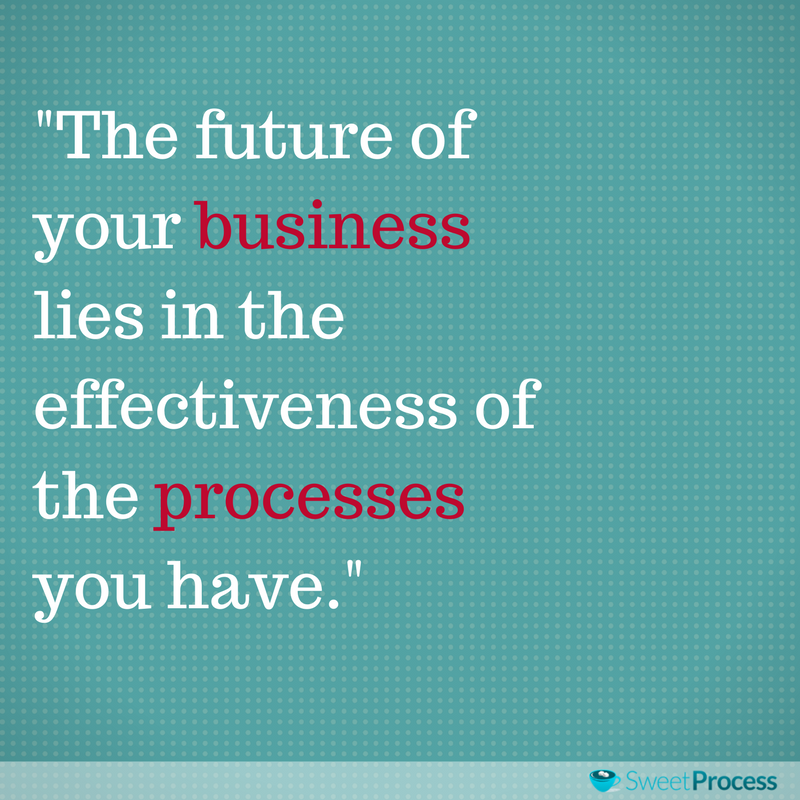
Maybe you've been working hard to outshine your competitors but haven't seen the desired results. The more you try, the more you lose your customers to them. Remember, business is like a battle; you must be on top of your game to succeed.
If you are a company or business owner losing your customers to your competitors, why not improve the quality of the product or service you offer? Why not make it easy for customers to get what they want quickly? Why not make their satisfaction your business's top priority? Why not consider reengineering your business process?
After all, business process reengineering is all about the customer. You focus on the quality of the process, rather than individuals. In the end, you increase the quality you offer to your customers by redesigning and improving your business processes.
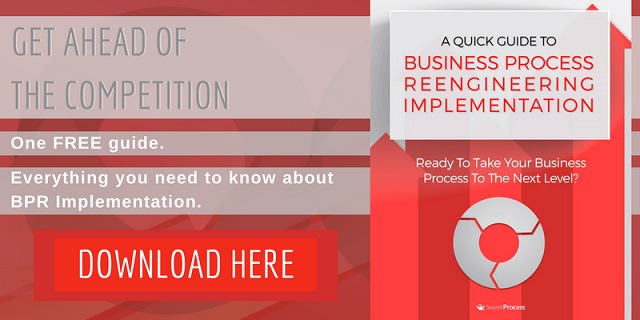
Get Your Free Systemization Checklist

5 Essential Steps To Getting a Task Out of Your Head and Into a System So You Can Scale and Grow Your Business!

graybealprety1958.blogspot.com
Source: https://www.sweetprocess.com/business-process-reengineering/
0 Response to "Business Process Reengineering is Quick and Easy"
Post a Comment